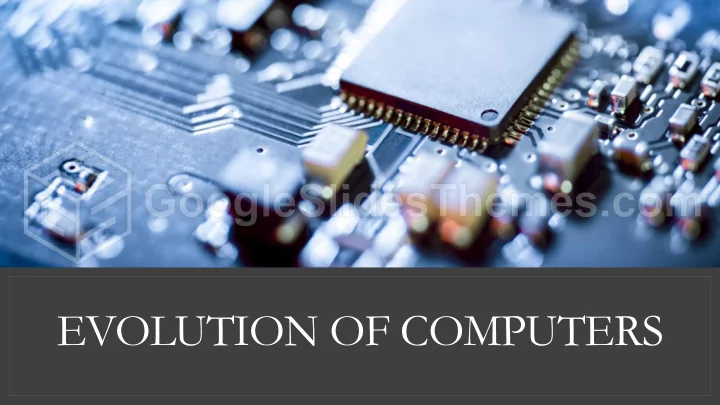

EVOLUTION OF COMPUTERS
History ◦ The first computer was invented in 1820s by Charlse Babbage. However the first electronic digital computer were developed between 1940 and 1945 in the United States and in the United Kingdom. ◦ In the beginning they were mainly used for arithmetic calculations . ◦ During the first half of the 20th century, many scientific computing needs were met by increasingly sophisticated analog computers , which used a direct mechanical or electrical model of the problem as a basis for computation. ◦ Then digital and Hybrid computers were invented and they are used till this day
Analog Computers ◦ Computer that uses the continuously changeable aspects of physical phenomena such as electrical, mechanical, or hydraulic quantities to model the problem being solved ◦ Analog computers often have a complicated framework, but they have, at their core, a set of key components which perform the calculations, which the operator manipulates through the computer's framework. ◦ Key hydraulic components might include pipes, valves and containers. ◦ In the 1950s to 1970s, digital computers based on first vacuum tubes, transistors, integrated circuits and then micro-processors became more economical and precise. ◦ Extraordinarily fast
Digital Computers ◦ Digital electronic computer is a computer machine which is both an electronic computer and a digital computer Examples of a digital electronic computers include the IBM PC, the Apple Macintosh as well as modern smartphones. ◦ A digital computer can perform its operations in the decimal system, in binary, in ternary or in other numeral systems ◦ A digital electronic computer is not necessarily a transistorized computer. ◦ Digital computers are inherently best described by discrete mathematics, while analog computers are most commonly associated with continuous mathematics.
Hybrid Computers ◦ Hybrid Computers are computers that exhibit features of analog computers and digital computers. ◦ Digital computers are very precise in calculating math equations ◦ Analog computers execute the operations at a very high speed ◦ The mix between the speed of the analog computers and the precision of the Digital computers . ◦ In the figure on the right is the first Hybrid computer created
Evolution of Operating System of the Computers ◦ Serial Processing ◦ Simple Batch Systems ◦ Multiprogram Batch Systems ◦ Time Sharing Systems
Serial Processing ◦ late 1940s to mid-1950s ◦ No operating system ◦ Machines run from a console with display lights, toggle switches, input device, and printer ◦ Challenges include: ◦ Scheduling: using a sign-up sheets ◦ Setup time: ◦ loading compiler and source program into memory ◦ saving the object program ◦ loading and linking object program and common functions
Simple Batch Systems ◦ Early computers were extremely expensive – Important to maximize processor utilization ◦ Mid-1950s : Batch OS (1rst OS of any kind!!) ◦ Use of Monitor i.e. Software that controls the sequence of events – ◦ Batch jobs together – each program returns control to monitor when finished.
Multiprogram Batch Systems ◦ CPU is often idle – Even with automatic job sequencing. – I/O devices are slow compared to the CPU. ◦ There are several issues : 1. which job should sit in memory 2. which CPU pick up 3. How to manage memory 4. What happens to the job which is suspended
Time sharing systems ◦ Provide user interaction with the computer system. ◦ more than one user interacting with the system at the same time!! ◦ Time sharing systems use: 1. Multiprogramming 2. Memory management scheme
THANK YOU !
Recommend
More recommend